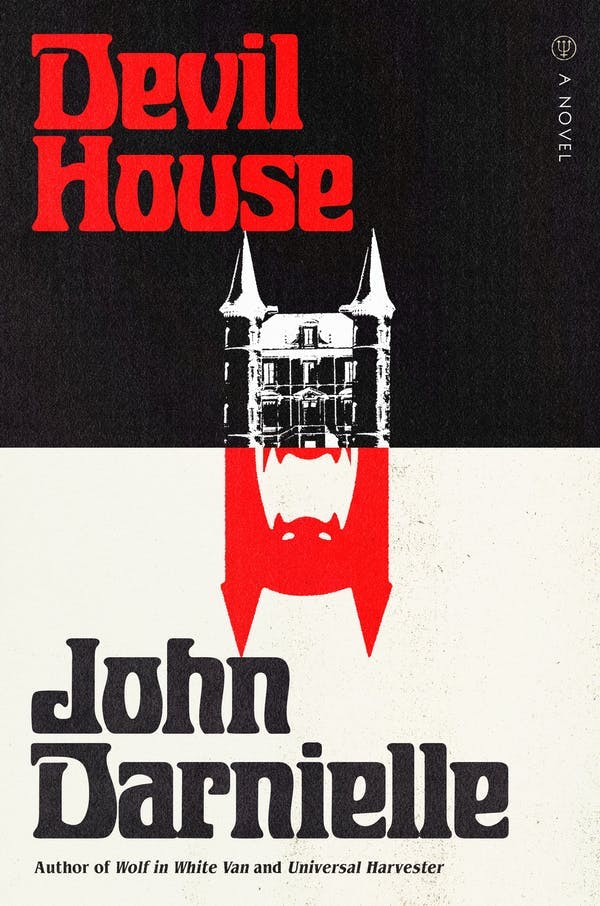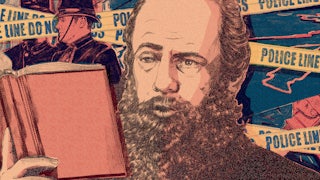A moderately successful true crime writer moves to the small city of Milpitas, California, to research a possibly satanic double homicide that occurred there in the 1980s. In fact, he has moved into the onetime porn store in which a realtor and her client were butchered with a two-handed broadsword, and as the novel progresses, he moves from research to resurrection, attempting to recreate the building as it had been on the night of the murders.

This is the arc of John Darnielle’s new novel, Devil House. Plenty of horror movies have been made with similar premises: the writer who becomes so obsessed with his disturbing subject that he finds himself pulled to reenact it. The book’s pulp-pastiche cover promises as much. But as in Darnielle’s 2017 novel Universal Harvester, the horror trappings are ultimately a bit of a red herring. Depravity is only one part of this story.
Darnielle, who is best known for his band the Mountain Goats, made his literary debut in 2008 with a volume on Black Sabbath’s Master of Reality in the 33 1/3 series, and in 2014 published the National Book Award–nominated novel Wolf in White Van. Over the past 30 years, Darnielle has used the Mountain Goats to expound a sort of small-scale, lo-fi humanism. His songs tell the stories of those on the losing end of transactions both daily and disastrous: mental ward patients and group home inmates, extinct species and characters from Scarface. But Darnielle is rarely voyeuristic; he gets inside his characters, exhibiting their passions as much as their pain. He has themed albums around epic fantasy and regional wrestling circuits, and his books are filled with outmoded, tactile pursuits: snail-mail role-playing games, small-town video stores, true crime paperbacks picked up at mall bookshops. His characters might not make the best choices, but they haven’t been given many options. “Do every stupid thing that makes you feel alive,” Darnielle sings on “Amy AKA Spent Gladiator 1.” “Do every stupid thing to try to drive the dark away.”
Where his prior novels turned inward, Devil House looks out on the world. Split into seven interlocking sections and told over centuries, the novel is an inventive exploration of which stories we prioritize and which we push down, in our popular hunger for narratives of crime, justice, and redemption. Darnielle marshals his many interests toward something approaching social critique. What kind of person, he wants us to ask, would write a book like this one? And why would anyone want to read it?
Narrated by a crime writer named Gage Chandler, Devil House is at times an investigation, a memoir, a piece of reportage, and, in its most elusive moment, the story of a British king by the name of Gorbonian, written in the sort of faux–old English favored by writers of low-rent swords and sorcery. When the novel begins, Chandler has been living in the titular Milpitas home for the past five years. The murder of the building’s owner and an aspiring real estate mogul decades earlier was attributed, at the time, to a cabal of teens enacting a satanic ritual. But Chandler has spent a career debunking sensationalistic stories, and so, at his editor’s suggestion, he moved in to uncover the truth behind the sensational reporting.
The novel’s middle pages come from the true crime book that Chandler has spent half of a decade piecing together. These sections focus on a group of teenagers who have moved into the abandoned premises of Monster Adult X and transformed it into their personal clubhouse. College-bound Derrick and medicated Seth invite their homeless friend Alex to sleep in the back, and soon enough classmate Angela has joined them. They decorate the store according to their wildest teenage fantasies, and what began as a hangout is soon something more: a place of protection, a castle, something worth defending.
In one of the novel’s best sequences, Darnielle relates in careful detail the modifications that Seth and Alex make to the porn store viewing booths, zooming in on the effects of “red sharpie, white correction fluid, and oily orange paint meant for indicating where it’s not safe for construction crews to dig” for the better part of five pages. Writing in a heightened, deliberately purplish tone—“Behold the first chamber,” it begins—he pays attention to quavering spray-paint lines, etchings into glass and plastic, and the sorts of imagery (wizards, witches, devils) that enliven pulp paperbacks and the album covers of also-ran metal bands. Where everyone else sees vandalism and possible depravity, Darnielle describes an earnest attempt at expression, provocation, and a kind of personal exorcism.
This is fundamentally a novel about whose perspectives we gravitate toward and whose we bury when telling stories about crime and suffering. As another writer tells Chandler at a conference: “There aren’t any villains in a true crime book. There’s the hero, and there’s his victims.” In what we see of his other books, Chandler strives to write a different kind of story. He wants to give life to the victims, rather than introducing them “on a conveyor belt that leads to the guillotine.” He wants them to exist, at least for a time, beyond the swathe of destruction that has brought them to his attention. “To understand the particulars,” he relates, is “to feel pity for the person who had borne the brunt of them.”
Yet Chandler often finds himself asking: Who’s the real victim here? His debut, The White Witch of Morro Bay, presents the story of a high school teacher who killed and dismembered two of her students, named Gene and Jesse, after they broke into her home. Darnielle devotes two separate sections to the story, placing them like brackets on either side of the Milpitas material. Neither reads like an excerpt from a true crime book. Presented in second-person present tense, they relate the crime from two perspectives: that of the teacher who committed it and that of Jesse’s mother. If the first seeks to exonerate the murderer (she was, Chandler thinks, “a blameless schoolteacher who paid a terrible price for defending herself”), the second reads more like a condemnation. In one very long letter, Jesse’s mother seeks to explain to Chandler the intense and unyielding pain that his book has caused her and to prove that there was more to her son’s life than his act of breaking and entering. The boy’s father terrorized both mother and son, leading Jesse to hold so tightly to his friend Gene that even when Gene proposed robbing their teacher, Jesse found himself incapable of saying no. Why had Chandler told the story of her son’s murderer, she asks, and not of her murdered son?
Darnielle wants to interrogate the stories we tell, and why. Toward the end, Chandler remarks: “We get so dazzled by the fireworks, by the conflagration I want to say, that we don’t see the gigantic expanse over there on the other side of the flames, but, you know. People have to live there.”
The trouble in Devil House is that very few people actually do live there. The novel switches between characters with such frequency that it can be hard to really understand them. Universal Harvester suffered from a similarly hopscotching perspective, moving from one character to another without taking the time to deepen them. Derrick and Seth arrive as sketches and leave as tropes—the conflicted senior, the medicated loner—and their friend Angela makes do with even less.
The novel’s best moments describe extremes. Darnielle expertly handles the violent scenes, presenting the death and dismemberment in a cool, controlled voice, heightening the horror by his refusal to obscure it. He depicts Jesse’s abuse and Alex’s bouts of homelessness and psychosis with a similar lack of obfuscation. Some of the novel’s most precise lines come from Alex’s perspective, the “high droning tones” and electrical currents that river through his consciousness, interrupting his reality. And in her final, climactic lines, Jesse’s mother lets loose her pain in a series of run-ons, making the formlessness of her constant grief at once visible and physical. The humdrum realism of the novel’s middle stretch just can’t compete.
When Chandler reaches the end of the mother’s monologue, the world no longer looks the same for him, but I wasn’t sure I’d learned anything new about Jesse at all. He had been consumed entirely by what Parul Sehgal recently termed “the Trauma Plot,” that tendency writers have lately taken toward prioritizing suffering in place of characterization. “Evoke the wound,” writes Sehgal, “and we will believe that a body, a person, has borne it.” Jesse is all wound, no person, swallowed up by a gauntlet of blows leading from childhood to body bag. Of course he was murdered, both mother and narrator agree; after what he suffered, did he ever have a chance?
As presented in these pages, real life can sometimes feel oddly denuded, only occasionally achieving the transgressive pathos of Darnielle’s best work. What about passion, and abandon, and feeling; what about a sense of life beyond the walls of Monster Adult X? Chandler’s story, and Darnielle’s, feel constrained by the bounds they have set for themselves.
Darnielle hasn’t always treated trauma so simply. In a trio of albums starting with 2004’s We Shall All Be Healed, Darnielle dug into his own past, including years of abuse at the hands of his stepfather, and periods of homelessness and methamphetamine addiction during his late teens and early twenties. These songs are certainly full of suffering, but their characters find all manner of ways to live with pain, to surmount it, even to transmute it into art. I love the tenderness of these albums, their refusal to cede all ground to suffering and pain even when those things seem overwhelming. His characters define themselves by something other than the traumas they’ve suffered. He gives them a deeper life beyond the pain, a possibility that only feels intermittently present throughout Devil House.
Or so I felt until the novel’s final section. It’s not possible to describe the book’s effect without revealing some essential plot points—and readers who want to preserve the surprise of discovering those twists for themselves may not want to read further until they’ve finished the book itself.
The book’s ending puts everything that came before into a new context. Speaking on the phone with a childhood friend, Chandler reveals that he has fabricated almost everything to do with the murders at Monster Adult X. Derrick, Alex, and Seth are pseudonyms for a group of homeless men who camped out in the storefront. There never was an Angela. They decorated their home and protected it—“castle doctrine,” as Chandler puts it—with whatever weapons were to hand, no satanic rituals necessary. In other words, the novel’s characters can feel flat because both Chandler and Darnielle have deliberately written them that way. In the narrator’s hands, cliché becomes a kind of battlement, fencing off the keep where his characters have taken shelter.
It’s a formally audacious move, a work of fiction-presented-as-truth nested inside this larger fictional project that serves, ultimately, as an exploration of writing fictionalized reality. Others have already explored the novel as a critique of true crime, a theme made explicit in its concluding pages. Digging into the ugly, miserable moments in a person’s life has become brisk business for streaming platforms like Netflix, and the murder-mystery podcast complex remains as popular as ever. Our appetite for real suffering appears bottomless.
“It matters which story you tell,” declares Chandler near the end, “it matters whose story you tell, it matters what people think even if it doesn’t matter to the people who needed it before the disaster hit.” By the novel’s conclusion, our narrator seems fully committed to telling the right story, even if doing so means he has to lie. The Milpitas murders will never become anyone’s favorite. By pulling the rug out from under the reader, Darnielle calls our reading experience into question, effectively forcing us to choose which of the two stories we prefer: the tragic crime or the sad truth?






